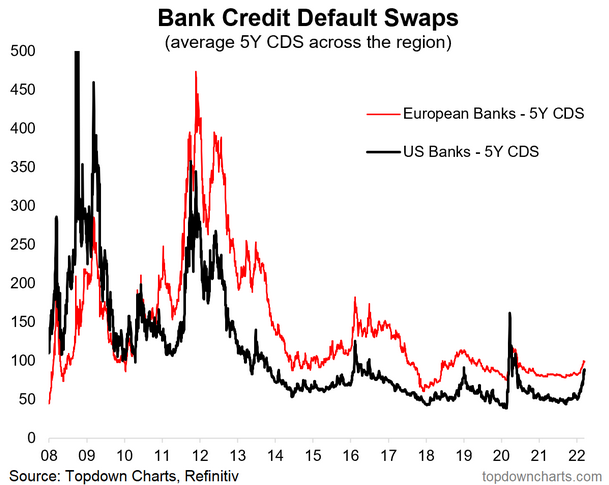This post was originally published at TopDown Charts
-
A rising US dollar index and increasing costs of "credit insurance" are hallmarks of risk-off behavior
-
US bank credit default swap pricing is rising to close the gap with Eurozone CDS
-
Credit risk pricing is higher in general with bond yields overall quite volatile
The global stock market continues to be on shaky footing. An increasing number of equity indices have reached (and punched significantly through) bear market territory. Are we nearing a bottom? It is hard to say, but price-action indicates there could be more pain ahead. Seasonality also portends a rough stretch now through the third quarter.
Plentiful Selling Pressure
Looking under the hood, we find that many small- and mid-cap stocks feature few signs of turning around. Among global equities, European markets have actually displayed some relative strength in the last week or so after plunging from mid-February through early March. Emerging markets, on the other hand, look dreadful as the group suffers its third-longest bear market since 1980. EM finally caught a huge relief rally on Wednesday.
A USD and CDS Check
Our Global Cross Asset Market Monitor report tracks many important indicators. We highlight what is happening with the US dollar this week and why its current level is key. Often, traders flock to the greenback during distressing times as a safety-trade. That is about what we have seen in recent weeks. Another sign of troubled times is what is happening with credit default spreads (CDS).
CDS Rates Rising
After becoming a household term following the Great Financial Crisis and again during the 2011 European sovereign debt debacle, CDS levels were not talked about much over the last ten years (sans a few short-lived panic periods such as the COVID Crash of 2020). But they are perking up now. Especially in the US.
A Bearish Indicator?
We find that US bank CDS rates, which is basically the cost to ensure bonds on financial companies, have risen sharply over the last three months. For proper perspective, 90bps on US bank CDS and slightly above 1% on European bank bond insurance is nowhere near what we saw back in 2008 and 2011-12. Still, the creep higher in the cost to insure bonds raises eyebrows. Do bond traders see more pain and market instability ahead?
Featured Chart: US and EU Bank CDS Rates

Uneasiness in the Fixed Income Markets
This is yet another caution flag traders must monitor as the year progresses. Higher CDS rates correspond with widening credit spreads and the selling of credit-risky bonds. We have already seen a 9% decline in US junk debt, a 13% drawdown for so-called high-grade corporate credit, and a whopping 17% move lower in Emerging Market bonds. They say that the bond market is smarter than the stock traders. So far, that cliché has been accurate in 2022.
Bottom Line: Credit defaults swaps have not quite hit the mainstream financial news networks yet, but we see some interesting moves in the cost to ensure financial bonds right now as geopolitics, inflation, and growth wobbles loom. US and EU bank CDS rates should be closely monitored by macro traders to keep ahead of risks and potential further risk-off behavior in global markets.
